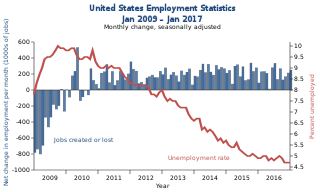
Unemployment, according to the OECD, is people above a specified age not being in paid employment or self-employment but currently available for work during the reference period.

The United States Department of Labor (DOL) is one of the executive departments of the U.S. federal government. It is responsible for the administration of federal laws governing occupational safety and health, wage and hour standards, unemployment benefits, reemployment services, and occasionally, economic statistics. It is headed by the Secretary of Labor, who reports directly to the President of the United States and is a member of the president's Cabinet.

The Bureau of Labor Statistics (BLS) is a unit of the United States Department of Labor. It is the principal fact-finding agency for the U.S. government in the broad field of labor economics and statistics and serves as a principal agency of the U.S. Federal Statistical System. The BLS collects, processes, analyzes, and disseminates essential statistical data to the American public, the U.S. Congress, other Federal agencies, State and local governments, business, and labor representatives. The BLS also serves as a statistical resource to the United States Department of Labor, and conducts research measuring the income levels families need to maintain a satisfactory quality of life.
A jobless recovery or jobless growth is an economic phenomenon in which a macroeconomy experiences growth while maintaining or decreasing its level of employment. The term was coined by the economist Nick Perna in the early 1990s.

Nonfarm payroll employment is a compiled name for goods, construction and manufacturing companies in the US. It does not include farm workers, private household employees, or non-profit organization employees.
In economics, the wage share or laborshare is the part of national income, or the income of a particular economic sector, allocated to wages (labor). It is related to the capital or profit share, the part of income going to capital, which is also known as the K–Y ratio. The labor share is a key indicator for the distribution of income.

The Conference Board, Inc. is a 501(c)(3) non-profit business membership and research group organization. It counts over 1,000 public and private corporations and other organizations as members, encompassing 60 countries. The Conference Board convenes conferences and peer-learning groups, conducts economic and business management research, and publishes several widely tracked economic indicators.

Workforce productivity is the amount of goods and services that a group of workers produce in a given amount of time. It is one of several types of productivity that economists measure. Workforce productivity, often referred to as labor productivity, is a measure for an organisation or company, a process, an industry, or a country.

The employment cost index (ECI) is a quarterly economic series detailing the changes in the costs of labor for businesses in the United States economy. The ECI is prepared by the Bureau of Labor Statistics (BLS), in the U.S. Department of Labor.
Produced by the Bureau of Labor Statistics (BLS) in the US Department of Labor, the National Compensation Survey (NCS) provides comprehensive measures of occupational earnings; compensation cost trends, benefit incidence, and detailed plan provisions. It is used to adjust the federal wage schedule for all federal employees. Detailed occupational earnings are available for metropolitan and non-metropolitan areas, broad geographic regions, and on a national basis. The index component of the NCS measures changes in labor costs. Average hourly employer cost for employee compensation is presented in the Employer Costs for Employee Compensation.

Initial jobless claims are a data point issued by the U.S. Department of Labor as part of its weekly Unemployment Insurance Weekly Claims Report. Initial jobless claims refer to claims for unemployment benefits filed by unemployed individuals with state unemployment agencies.

The Organisation for Economic Co-operation and Development defines the employment rate as the employment-to-population ratio. This is a statistical ratio that measures the proportion of a country's working age population that is employed. This includes people that have stopped looking for work. The International Labour Organization states that a person is considered employed if they have worked at least 1 hour in "gainful" employment in the most recent week.
In economics, the business sector or corporate sector - sometimes popularly called simply "business" - is "the part of the economy made up by companies". It is a subset of the domestic economy, excluding the economic activities of general government, of private households, and of non-profit organizations serving individuals. The business sector is part of the private sector, but it differs in that the private sector includes all non-government activity, including non-profit organizations, while the business sector only includes business that operate for profit.

Unemployment in the United States discusses the causes and measures of U.S. unemployment and strategies for reducing it. Job creation and unemployment are affected by factors such as economic conditions, global competition, education, automation, and demographics. These factors can affect the number of workers, the duration of unemployment, and wage levels.

Manufacturing is a vital economic sector in the United States. The United States is the world's third largest manufacturer with a record high real output in Q1 2018 of $2.00 trillion well above the 2007 peak before the Great Recession of $1.95 trillion. The U.S. manufacturing industry employed 12.35 million people in December 2016 and 12.56 million in December 2017, an increase of 207,000 or 1.7%. Though still a large part of the US economy, in Q1 2018 manufacturing contributed less to GDP than the 'Finance, insurance, real estate, rental, and leasing' sector, the 'Government' sector, or 'Professional and business services' sector.
Statistics on unemployment in India had traditionally been collected, compiled and disseminated once every ten years by the Ministry of Labour and Employment (MLE), primarily from sample studies conducted by the National Sample Survey Office. Other than these 5-year sample studies, India has – except since 2017 – never routinely collected monthly, quarterly or yearly nationwide employment and unemployment statistics. In 2016, Centre for Monitoring Indian Economy – a non-government entity based in Mumbai, started sampling and publishing monthly unemployment in India statistics.
Job creation and unemployment are affected by factors such as aggregate demand, global competition, education, automation, and demographics. These factors can affect the number of workers, the duration of unemployment, and wage rates.
The Survey of Occupational Injuries and Illnesses or the SOII program is a Federal/State cooperative program that publishes annual estimates on nonfatal occupational injuries and illnesses. Each year, approximately 200,000 employers report for establishments in private industry and the public sector. In-scope cases include work-related injuries or illnesses to workers who require medical care beyond first aid. See the Occupational Safety and Health Administration (OSHA) for the entire record-keeping guidelines. The SOII excludes all work-related fatalities as well as nonfatal work injuries and illnesses to the self–employed; to workers on farms with 11 or fewer employees; to private household workers; to volunteers; and to federal government workers.











